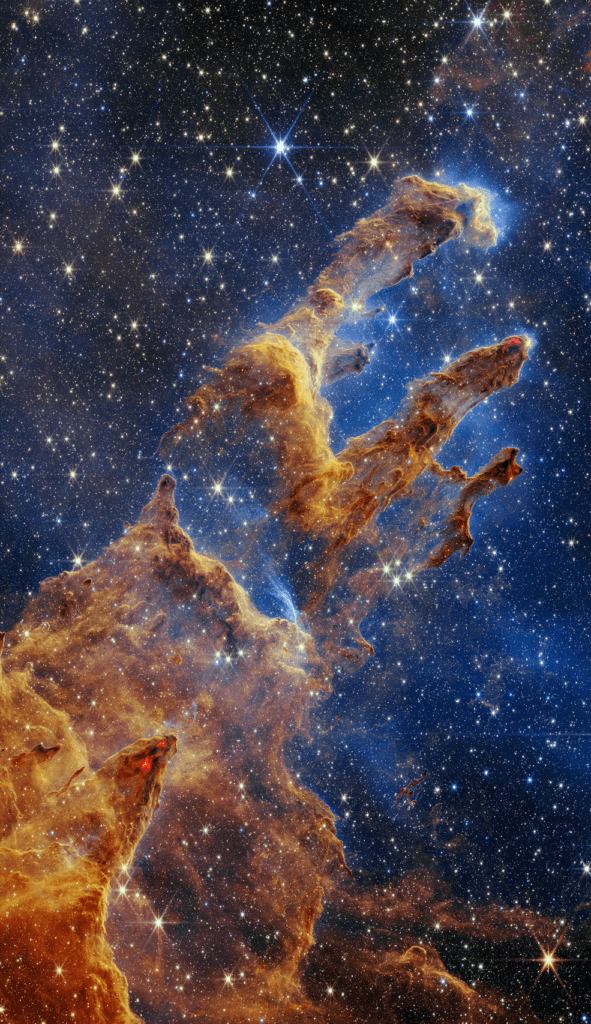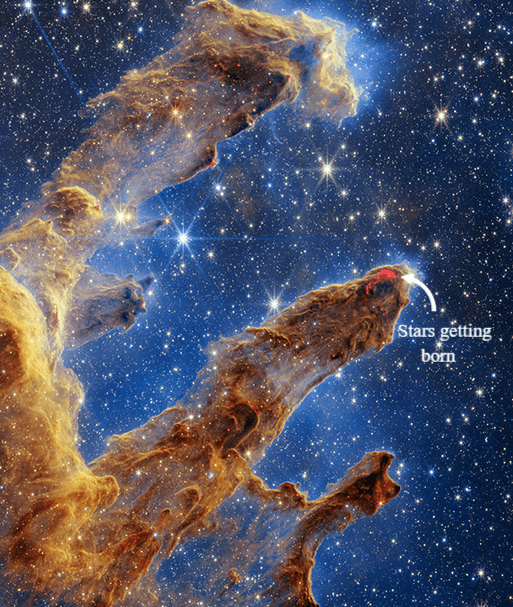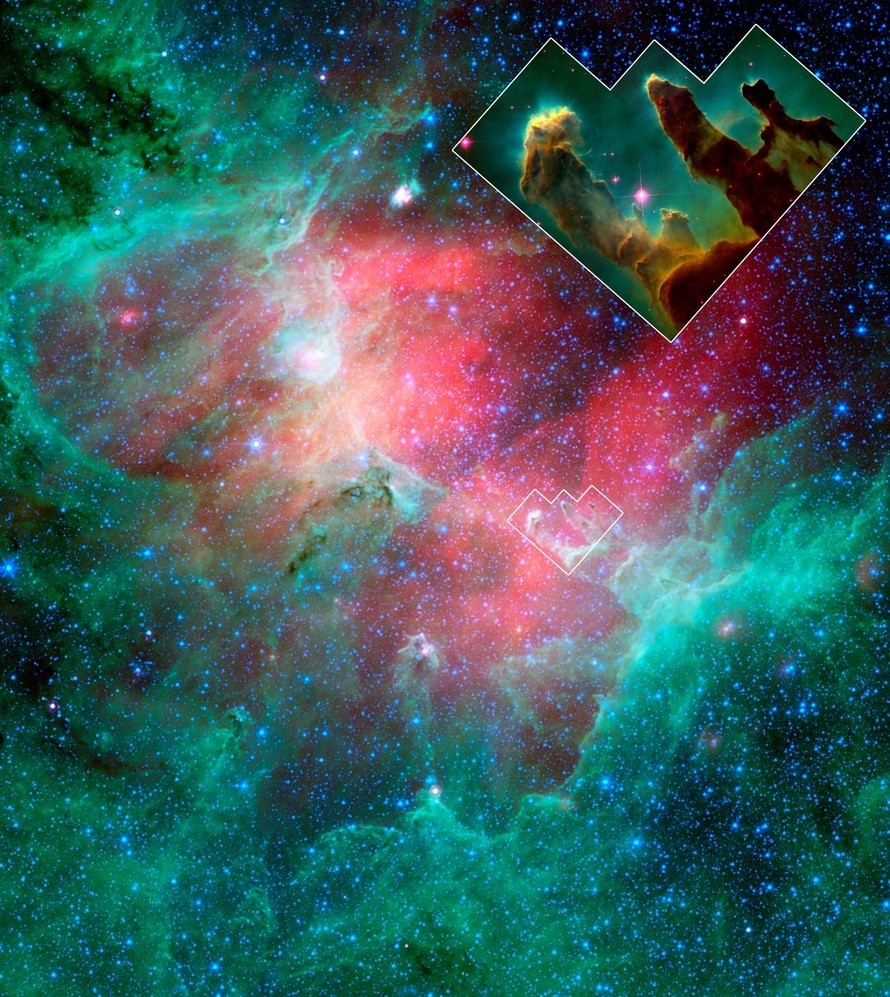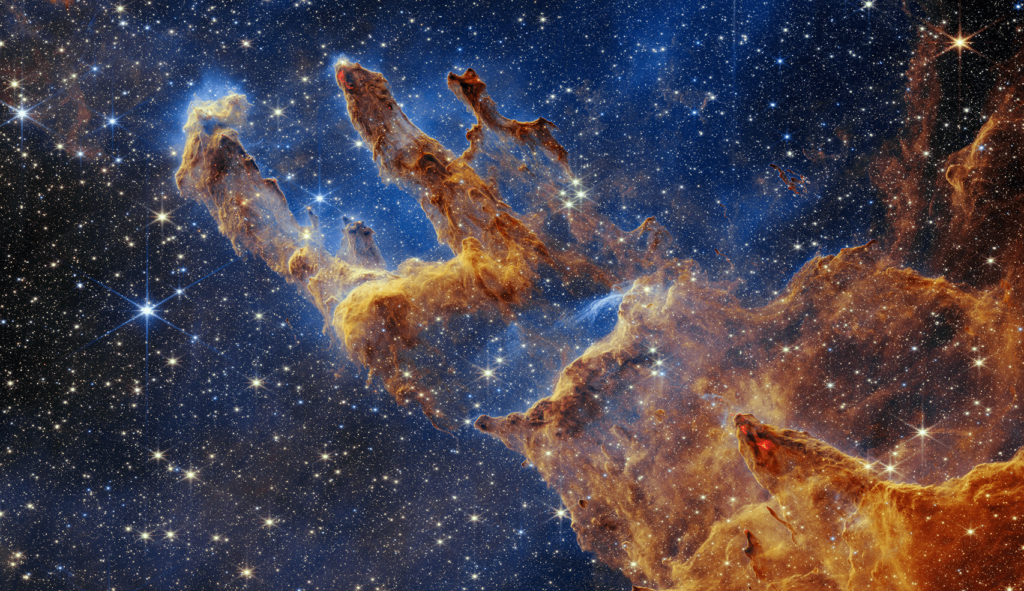Located around 6500 light years away, in the constellation Serpens Cauda, a region of space is brimming with star formation processes. Lying within the Eagle Nebula, these gigantic sprouts of interstellar dust and gas resemble pillars, and have congruously been named the ‘Pillars of Creation’.
Read our detailed analysis on James Webb’s first images by clicking here.

Why are they called the Pillars of Creation?
These structures are literally star-manufacturing factories where new stars are continually being born amidst cosmic events. In these regions of dense matter, gravity becomes dominant and causes the prevalent gas to contract. Dust act as a catalyst to set off fusion. Together, they eventually give birth to stars.
Are the pillars in our own galaxy?
With only 6500 light years away from Earth, these pillars are within Milky Way. Though the scale is quite small with respect to the size of our galaxy (diameter of 100,000 light years), still, they are much farther away from us.
Considering an approximation of the average human lifespan of 70 years (the United Nations had estimated it to be 72.6 years in 2019 and it has not significantly changed since then), it would still take around 93 human generations to reach the pillars if they manage to travel at the speed of light – 300,000 km/sec (which is again not plausible with the current technology or in the near future).

When were the Pillars of Creation first photographed?
The Hubble Space Telescope first looked at these pillars in the year 1995. They stood out in the backdrop of a surreal landscape like the stalagmites growing up from a cave floor. The leftmost pillar, which is also the tallest, is about 4 light-years (~38 trillion km) long.
The newborn stars are releasing ultraviolet light during their formation (visible at the top edge of the left pillar), and are slowly eroding away the molecular hydrogen gas and dust, as a part of the ‘photoevaporation’ process.

The different colors in this image tell us about the presence of different elements. Red indicates the presence of sulfur atoms, green shows emission from hydrogen, and blue depicts light transmitted by oxygen atoms.
Focusing its lenses once again in the year 2015, Hubble captured the pillars with more refinement. The dust and gas seem to be scorched by the extreme radiation emitted by the young stars and abraded by the powerful stellar winds from the nearby massive stars.

What changed in the 2022’s photograph of the Pillars of Creation?
James Webb Space Telescope (JWST), the successor to Hubble, has recently captured a stunning image of the iconic pillars. In this newly infrared light, the Pillars of Creation appear more permeable and semi-transparent.

Even though the whole image is a treat to the eyes, the attention stealers are the bright red orbs at the tip of one of the pillars (prominently in the middle one). In these lava-like red areas, stars are still being born (the star formation event being discussed here is 6500 years ago as the light from the pillars took that many years to reach us).

The massive collection of space dust and gas provides an ideal condition for the formation of new stars – they act as cosmic incubators. The regions of higher densities in these clouds give way to gravity, forcing the surrounding particles to collapse inwards and ignite, forming new stars.
During this process, the infant stars spill out gas (known as jets). When the energetic hydrogen molecules present in these jets collide with the interstellar dust, they give rise to the red glow. These young stars are relatively young in the timescale of the universe – estimated to be only a few hundred thousand years old.
These jets, in collision with the clouds of gas and dust, may sometime also result in bow shocks, thereby creating wavy structures as evident in the middle of the image. The presence of magnetic fields cannot be refuted either as they help in giving wavy patterns to these structures.

Why aren’t there any galaxies in the recent image?
Each point of light is a star in this image. An interesting point to note is the lack of any galaxies which are abundant in the other images captured by the James Webb telescope. It is due to the fact that the Pillars of Creation lie exactly in the plane of our galaxy, the Milky Way, where it is the densest. The presence of interstellar medium (a combination of interstellar dust and gas) hinders our view of much of the further and deeper universe.
Why is this photograph important?
We have been relying upon models and simulations to know about the very early stages of stars formation and there is still much more to learn in that frontier. James Webb’s new image of the Pillars of Creation will help researchers to accurately measure the number of stars and the amount of gas and dust in the region. This will, in turn, provide a way to gain a clearer understanding of how stars form and burst to life from their dusty cocoons over millennia.
Are the pillars still there and what is in store for our descendants?
A group of scientists has put forward a theory according to which there had been a supernova (an energetic and luminous explosion of a star near the end of its cycle) in the vicinity of that region as captures by the Spitzer Space Telescope. The supernova occurred around 6000 years ago and from its intense radiation and shockwave, the pillars got destroyed.

Since the pillars are 6500 light years away and probably got destroyed 6000 years ago, because of the time taken by the light to reach us, humans would continue to appreciate their beauty for another 500 years or so.
Imagine your descendants 500 years later looking at the night sky through a telescope. Their eyes would be witness to one of the most amazing space events in the history of humankind – the appearance of the supernova’s shock wave initially, pillars getting eroded gradually, and then toppling to its base.

There would be no sign of the pillars at all – the Pillars of Creation would finally be destroyed in the series of aforementioned events.
However, as every generation’s knowledge and wisdom is laid on the foundation of its predecessors, they would definitely comprehend that it had actually happened thousand years ago. They would think about us and imagine how the pillars would have looked in our timeframe – though very small but yet meaningful.

